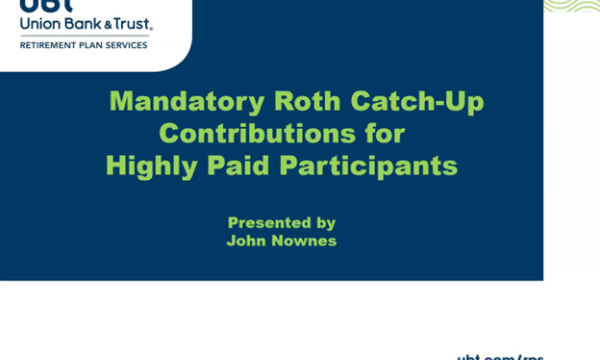Investment Overview: 3rd Quarter 2025

The economy
The U.S. economy remained resilient in the third quarter of 2025, with growth supported by robust consumer spending and a rebound in business investment, even as elevated tariffs and persistent inflation continued to pose challenges. U.S. economic growth projections held steady, with annual GDP expected to fall within the 1.5%–2% range for 2025. Looking ahead to 2026, growth is anticipated to dip below 2% as the economy contends with tariff-driven inflation, weaker consumer spending, ongoing policy uncertainty, and a softer labor market.
Tariff rates remained elevated in Q3, reaching an average effective rate of 18%, the highest since the 1930s. The current administration’s “reciprocal” tariff policy has become a permanent fixture, with new 15% tariffs on most EU goods and ongoing levies on China and other trading partners. While these tariffs are expected to generate significant government revenue, their costs are being passed directly to consumers and businesses, raising prices and dampening demand. Trade uncertainty remains a top concern for manufacturers.
U.S. manufacturing activity remained in contraction throughout the third quarter with the ISM Manufacturing PMI registering 48.0 in July, 48.7 in August, and 49.1 in September. While the pace of decline has slowed, the index stayed below the 50-point threshold, signaling ongoing weakness in the sector. New orders and employment continued to contract, reflecting subdued demand and persistent headwinds from tariffs and elevated input costs. Survey respondents cited ongoing macroeconomic challenges which have led to cautious purchasing decisions and margin pressures. Overall, manufacturers are facing a challenging environment, with only a handful of industries reporting growth and the majority still contending with depressed orders and cost concerns.
The labor market has shown signs of softening in recent months. The unemployment rate remains low at 4.3%, but is up from 4.1% earlier in the year. Job creation slowed, with non-farm payrolls rising by just 22,000 in August. Wage growth remains positive at 3.5% year-over-year, but hiring demand is limited and layoffs have increased, particularly in the government sector. The weaker job market and worries about inflation have led to an erosion of consumer confidence, with the Conference Board’s Consumer Confidence Index falling to its lowest level since April. Despite some optimism among younger consumers, confidence has dropped across most age and income groups, and Americans’ views of their own finances have dimmed, recording the steepest one-month drop since mid-2022. The September report suggests Americans are increasingly cautious about the present — particularly jobs and household finances — and economists warn that this could lead to weaker consumer spending in the months ahead.
Inflation has stabilized but remains above the Federal Reserve’s target. The annual inflation rate was 2.9% for the 12 months ending August, up from 2.7% previously. The Fed projects core inflation to average 3.1% for 2025, with tariff-related price pressures expected to keep inflation elevated through year-end.
Global GDP is projected to be around 3.0% for both 2025 and 2026, down from 3.3% in 2024. Advanced economies are expected to grow at 1.3%–1.6%, while emerging markets benefit from front-loaded exports ahead of U.S. tariffs. The Eurozone and Japan face muted prospects due to trade uncertainty, while China’s outlook is buoyed by fiscal stimulus but challenged by deflationary pressures.
The third quarter of 2025 highlighted the resilience of the U.S. economy amid persistent headwinds from tariffs, inflation, and policy uncertainty. While consumer spending and AI-driven investment have provided support, the drag from trade barriers and a cooling labor market point to slower growth ahead. Global risks remain elevated, and investors should prepare for continued volatility as the effects of protectionist policies and geopolitical tensions play out.
Fixed income
Fixed income markets performed well over the third quarter as economic growth concerns and an accommodative Fed overtook inflation fears. Interest rates fell across the maturity spectrum, with shorter-term rates falling more than their longer-term counterparts. This resulted in continued yield-curve steeping. Despite evidence of a slowing labor market, investment-grade and high-yield credit spreads continued to narrow and are now at multi-decade lows.
The 10-year Treasury Bond finished the quarter with a yield of 4.15%, down from 4.23% at the start. Meanwhile, the 2-year Treasury yield decreased 11 basis points to end the quarter at 3.61%. The Bloomberg Aggregate Index finished the quarter up a respectable 2.03%, indicative of broad-market bond performance, as bond prices move inversely to interest rates.
Of particular note, market participants witnessed a significant monetary policy shift over the course of the quarter. While the Federal Reserve held rates steady at its July meeting, minutes from the meeting revealed division among policymakers, with two members dissenting in favor of a 25-basis point rate cut. This marked the first instance in over 30 years where multiple Fed governors dissented in favor of easing during a rate-hold decision.
Moving into September, the Federal Open Market Committee this time voted unanimously to lower its target rate by 25-basis points citing slowing economic growth and rising risks to the labor market. The Fed Funds rate now stands at a target range of 4.00-4.25% with two more rate cuts projected by year-end.
As we move into the fourth quarter, Fed policy is likely to be shaped by evolving inflation dynamics given the potential for further labor market deterioration against a backdrop of tariff-related price pressures. The Fed is currently projecting just one rate cut in 2026, signaling a cautious approach despite market expectations for more easing. Fed caution appears warranted given that core inflation is likely to remain well above the Fed’s 2% target for the foreseeable future.
Treasury yields of selected maturities for recent time periods are displayed below (data from Bloomberg).
| Treasury Bill | Treasury Notes & Bonds | ||||
|
3 mo. |
2 yr. |
5 yr. |
10 yr. |
30 yr. |
|
| 09/30/2025 |
3.94% |
3.61% |
3.74% |
4.15% |
4.73% |
| 06/30/2025 |
4.30% |
3.72% | 3.80% | 4.23% | 4.78% |
| 03/31/2025 |
4.30% |
3.89% |
3.95% |
4.21% |
4.57% |
Total return numbers for various fixed income indices over the past quarter and 12 months are below (data from Bloomberg).
| Fixed Income Returns | ||
| Fixed Indices | 3rd Qtr. 2025 | Last 12 mos. |
| BBerg US Aggregate Index |
2.03% |
2.88% |
| BBerg Intermediate US Gov./Credit Index |
1.51% |
4.01% |
| ICE BofA US Corporate Bond Index |
2.65% |
3.92% |
| ICE BofA US High Yield Bond Index |
2.40% |
7.23% |
| BBerg Global Aggregate Bond Index |
0.60% |
2.40% |
| ICE BofA AAA US Municipal Securities Index |
3.19% |
1.20% |
Equities
Third-quarter equity markets again posted strong returns, continuing the rally following the steep (but brief) pullback in April following the uncertainty around the initial tariff announcements. At quarter-end, the S&P 500, Dow Jones Industrial Average and Nasdaq Composite Index are hovering near record highs, while the small-cap Russell 2000 index hit its first record high since 2021.
Although breadth improved from the second quarter, the market is still largely powered by the biggest companies. The “Magnificent Seven” tech-related companies account for over 35% of the S&P 500s overall market capitalization. On a more positive note, nearly all styles of investing (large and small, growth and value, domestic and foreign) chalked up solid gains in the third quarter.
Driving the stock market higher was a combination of a resilient economy, continued corporate profitability, and a well-behaved bond market. Further, the uncertainties of the trade war and tariff policies have yet to show a meaningful impact on profits or inflation.
The most important driver of stock market returns is the level of earnings, and as third quarter earnings are reported over the next several weeks, they are expected to show the ninth consecutive quarter of growth. Despite headwinds and uncertainties, companies have found ways to increase revenues, margins, or both, mainly driven by consumer spending and investments in technology.
One of the most surprising stories of 2025 has been the exceptionally strong performance of international markets. Both the developed market and emerging market benchmarks have posted year-to-date gains of over 25%. While not a favored asset class going into the year by many investors, foreign markets have performed well due to a variety of factors including a weaker dollar and more spending on defense and infrastructure abroad. As we have mentioned in the past, better relative valuations have also played a part in outperformance once these catalysts began to manifest themselves.
After a very strong start to 2025 with double-digit gains nearly across the board, worries of a “frothy” market have surfaced. For example, the S&P 500 now trades at about 23 times its expected earnings over the next 12 months, well above its average multiple, and the popular index has notched 28 record highs so far this year. IPOs are back in vogue, with an average first day jump of 34%, the highest in 25 years. Special-purpose acquisition companies, or SPACs, have raised $20 billion this year, the highest since 2021, and retail traders seemingly have had an outsized impact on single-stock moves.
While the “bubble” characteristics are up for debate, the overall stock market is expensive by nearly all valuation metrics versus historical standards. The question of how long strong gains can continue centers on whether the largest and most expensive companies can retain their impressive growth rates. We continue to have cautious optimism for equities in light of the profit outlook and interest rate backdrop, but believe that international and smaller (non-mega-cap) stocks present relatively attractive investment opportunities.
Below is a table displaying various equity index returns for the past quarter (data from Bloomberg).
| Equity Indices | 3rd Qtr. 2025 | YTD 2025 |
| S&P 500 |
8.11% |
14.81% |
| Dow Jones Industrial |
5.67% |
10.47% |
| NASDAQ |
11.43% |
17.96% |
| S&P 500 Growth |
9.78% |
19.50% |
| S&P 500 Value |
6.20% |
9.68% |
| Russell 2000 (small-cap) |
12.39% |
10.38% |
| MSCI/EAFE (developed international) |
4.87% |
25.83% |
| MSCI/EM (emerging markets) |
10.92% |
28.17% |
Sector returns
Third quarter sector returns were more consistent versus prior quarters, with 10 out of the 11 sectors showing positive returns for the quarter. Stocks from nearly all areas of the U.S. economic landscape have seemingly adjusted to the rapidly changing trade negotiations and geopolitical conflicts. The somewhat surprising rally in stocks continued and was still led by growth-focused stocks, largely riding the AI wave.
While the vast majority of sectors showed gains for the quarter, the biggest winners resided in the same sectors that showed the biggest gains in the second quarter, namely Technology and Communication Services. These sectors are dominated by mega-cap companies, many of which continued to see strong demand and retained their elevated P/E multiples due to their growth prospects.
Consumer Staples was the only negative sector for the quarter, as it, along with Health Care, which are traditionally viewed as more defensive areas of the market, are the two worst-performing sectors year-to-date. Many Consumer Staples companies are dealing with higher input prices and tepid demand, while Health Care companies face uncertainties regarding government policies.
Interest rates remained well-behaved during the quarter, which provided another tailwind for many stocks. Growth stocks benefit from a lower discount rate, while rate-sensitive areas including Utilities and Real Estate generally perform well in lower rate environments.
As we move into the final quarter of 2025, many investors harbor hopes of a continuation of broader stock market participation. Valuations appear stretched for some of this year’s winners. Further, the ultimate outcome of many government policies remains unknown, meaning some of the lagging areas of the market may come back in favor due to their less expensive valuations.
The following table details S&P 500 sector total returns for the quarter (data from Bloomberg).
| Return by Stock Sector | 3rd Qtr. 2025 |
| 1. Information Technology |
13.19% |
| 2. Communication Services |
12.04% |
| 3. Consumer Discretionary |
9.54% |
| 4. Utilities |
7.57% |
| 5. Energy |
6.21% |
| 6. Industrials |
4.91% |
| 7. Healthcare |
3.76% |
| 8. Financials |
3.22% |
| 9. Basic Materials |
3.10% |
| 10. Real Estate |
2.59% |
| 11. Consumer Staples |
-2.36% |
|
Learning Center articles, guides, blogs, podcasts, and videos are for informational purposes only and are not an advertisement for a product or service. The accuracy and completeness is not guaranteed and does not constitute legal or tax advice. Please consult with your own tax, legal, and financial advisors.




